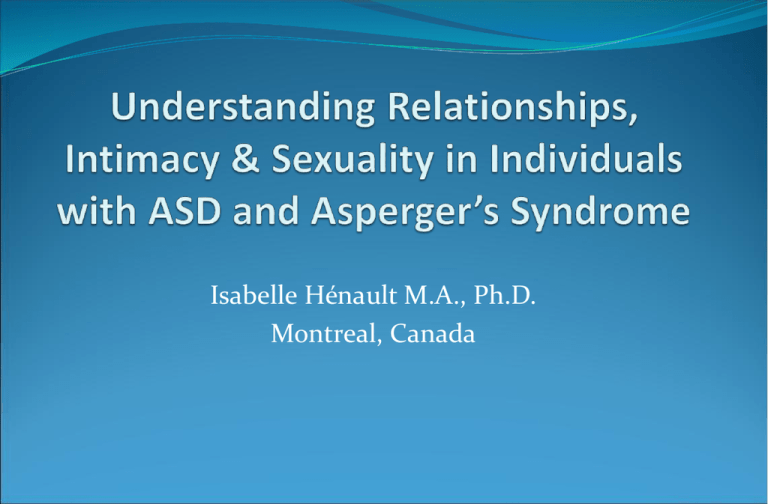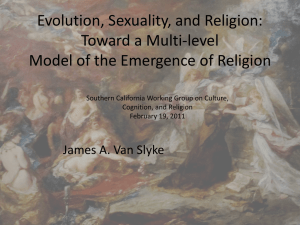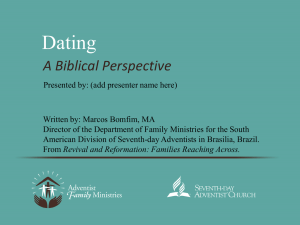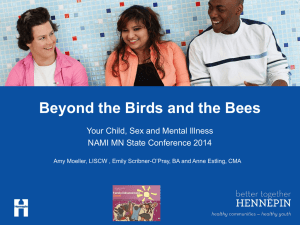
Isabelle Hénault M.A., Ph.D.
Montreal, Canada
Definition of sexuality
Few research & clinical attention
Normal part of development and life
Complexity of sexuality: more than behaviours!
www.jkp.com
ASD & Asperger’s profile
Social skills: free of social rules
Communication abilities: verbal and non verbal
Theory of Mind: different ways of thinking?
Emotions: detecting, reading, expressing
Sensory issues
ASD & Asperger’s profile
Sexual behaviours: self-stimulation, exploring sexuality,
lack of experience
Frustrations and inappropriate behaviours: paedophilia,
preferences, fetishism, compulsions
Gender identity & role definition: « My way »
flexibility, conflict, confusion
cross-dressing, transsexualism
Social imitation: context, consent
ASD & Asperger’s profile
Interpretation of emotions: black & white!
Interpersonal relationships: couples, empathy,
intimacy. Confusion & anxiety, resentement
Sexual drive, desire, curiosity
Accepting the diagnosis
Factors influencing social and sexual
development (Griffiths, 1999)
Information
Basic knowledge
Experiences
Social support
Limitations of the environment
Gender segregation
Social network
Rules
Sex education
Factors influencing social and sexual
development
Intimacy
Interests and limits
Private and public setting
Exploration
Medication
Secondary effects
Synergic effects
Infections
Monitored
HFA- Asperger’s Syndrome and
Sexuality Research
Do individuals diagnosed with HFA-AS have a sexual
profile dinstinct from their peers?
Actual literature
Lack of research, data
Sexual development and interest
Communication and social skills difficulties
Depression, anxiety and other psychiatric disorders
Sexual development
Inappropriate behaviours
Experimentation
Derogatis Sexual Functioning Inventory (DSFI, 1982)
Self-report questionnaire, confidential
11 aspects of sexuality measured
Scores compared to norm of general population
AQ Test (Baron Cohen et al., 2002)
Experimentation
Subjects
N: 131 adults
88 men and 43 women (3 transgendered male to female)
Age: M: 38
Range 18 to 68 years
Diagnosis:
126 AS
5 High Functioning Autism
Experimentation
Nationality
22 Canada
61 Australia
7 USA
Status
60 single
71 relationship
6 France 28 Denmark
3 Belgium
4 UK
Subscales Results
1-Information
2-Experience
3-Drive
4-Attitude
5-Symptoms
6-Affects
7-Role Definition
8-Fantasy
9-Body Image
10-Satisfaction
11-GSS
(M= 43
(M= 42
(M= 44.5
(M= 46.5
(M= 35.7
(M= 37
(M= 48
(M= 51
(M= 35.5
(M= 41
(M= 47
SD= 13)
SD= 13)
SD= 10.4)
SD= 12.6)
SD= 9.4)
SD= 11.4)
SD= 13.4)
SD= 14.5)
SD= 12.7)
SD= 11.3)
SD= 12.1)
Sexual Profile of Adults with Asperger's syndrome
Henault, Attwood& Center for Autism (2010)
Série1
AS
group
60
50
Mean scores
40
30
20
10
0
1
2
3
4
5
6
7
8
9
10
11
Série1
43
42
44,5
46,5
35,7
37
48
51
35,5
41
47
Série2
50
50
50
50
50
50
50
50
50
50
50
Sub scales
Série2
NT
group
Low Scores
Body Image: 35.5
Negative self-image
Unhappy about genitals, physical appearance
Unattractive: decrease of sexual activity
Sensitivity about self-image
Symptoms: 35.7
Pain in the body, insomnia, digestive problems
Agitation, loneliness
Guilt, anxiety and depression in 65% AS(Attwood,CBT, 2002)
Comorbidity
Low Scores
Affects: 37
Sadness, tense and bitter
Depression and anxiety
Low self-esteem
Sexual satisfaction: 41
Activities, partner, variety, interest
“There is not enough variety in my sex life”
“Often, I worry about my sexual performance”
Mean scores
Experience: 42
Age sexual interest: 14 years
First experience: 21 years
26 virgins subjects (18 to 40 years)
Lack of experience
Information: 43
Mediocre general knowledge: superficial-practical
Curiosity
Sexual experience
Mean scores
Sexual drive: 44.5
Frequency of behaviours (actual and desired)
Sexual fantasy
Despite limited experience, sexual desire
High scores
Positive attitude: 46.5
Moral judgement and social conventions
Liberal values
Open-minded
General Sexual Satisfaction: 47
All subscales
Importance of sexuality in one ’s life
Improvement, experiences, knowledge
Highest scores
Role Definition: 48
Gender issues according to their personality
Gender flexibility/social rules
Fantasy Life: 51
Rich and diverse
Stimulations, positions, homosexual, erotic material
Variety larger than list!
Discussion
Sexual desire, rich fantasies, sexual roles
Positive attitude
Incidence of homosexuality
Role definition and Gender Identity Disorder
Comorbidity of AS & GID?
Flexibility in sexual orientation
Sexual and social behaviours
No distinction between men and women, cultural:
Negative body image
Limited knowledge
Symptoms of depression and anxiety and other psychiatric
disorders
Restrictive environment
Confusion in socio-sexual situations and need for sex
education
Higher risk of sexual abuse in ASD
Support and strategies
Goals
Improve self-esteem and interpersonal exchanges
Decrease isolation and depression
Establish friendships and intimacy
Provide knowledge and positive experiences
Consultations: individual couples & groups
Healthy sexuality = Quality of life
Outcomes
Dinstinct sexual profile of ASD & Asperger ’s adults
Need for ongoing research
Development of sex education and counseling programs
Typical
History
of
Relationships.
Late developer in social/emotional maturity.
Not sexist, ageist or culturally biased in choice
of friends and partner.
Wanting to be a friend and lover but with
little intuitive knowledge and experience of
how to do either.
What Attracted You to Your Partner?
The silent handsome stranger.
Admiration of intellect or abilities.
Compassion for his/her limited social skills.
Belief his or her character was due to childhood
circumstances and the person will change in a new
relationship.
What Attracted You to Your Partner?
Shared interests (hobbies, animals).
The degree of adulation.
Fidelity in relationships.
What Attracted You to Your Partner?
‘Pillar’ of the community.
Child like quality, a ‘Peter Pan’.
Creative in his/her work and good career prospects.
Similar characteristics to a parent (learned the language
and culture in childhood).
What Attracted You to Your Partner?
A challenge to get to know.
I was his first serious relationship.
Not ‘macho’.
Choice of Partner
Women with AS may prefer a relationship with a man
with As.
Extreme neurotypicals more likely to fall in love with an
Aspie.
Adults with High Functioning Autism less likely to seek a
partner.
The development of the relationship
An initial extremely deep love for the partner with ASD-
AS.
In the early years of the relationship, not expecting the
partner with ASD-AS to know what the person is
thinking or needs.
The extreme neurotypical can imagine the ASD-AS
perspective but the partner with ASD-AS can have great
difficulty imagining the NT perspective.
What signs indicated he/she was
different?
Indifference e.g. Early attentions in courtship stage
vanished
Dominance of hobbies in time
Resist being changed
Reduction in social life
Emergence of obsessive compulsive routines
Less need for social relationship with partner
Problem processing what you say and cannot change
mind with more information
Paranoia- e.g. you did something deliberately to annoy
them
All your fault
Phenomenal memory of what you have said and
repeating it
Unaware of how to handle people close to you
Difficulty resolving conflict
Unable to discuss issues
Wanting to be mothered but fighting and resisting that
No concept of time
Individual Activity: List the
characteristics of love
Love is: Tolerance, non-judgemental, supportive.
Love is: A complex of beliefs that tap into our
childhood languages and experiences; it is inspired
when you meet someone that has a quality that maybe
you admire, or do not have (admiration and respect) –
or that they (someone you admire) reflects back to
your ideal self – which is what you want to be or see
yourself as.
Love is: Passion, acceptance, affection, reassurance,
mutual enjoyment.
Love is: What I feel for myself when I am with another
person.
Emotional bonding
Sharing and support
Balance of independence and dependence and being
comfortable with that person
Long term commitment
ASD-AS Partner Definitions
ASD-AS definitions
Love is: Helping and doing things for your lover.
Love is: An attempt to connect to the other person’s
feelings and emotions.
Love is: Companionship, someone to depend on to help
you in the right direction.
Love is: I have no idea what is involved.
Love is: Tolerance, loyal, allows ‘space’.
Four aspects of love: everybody, friends, family, erotica.
Love cannot be observed.
Love is yet to be felt and experienced by myself.
What is Love? I don’t know the correct answer.
Euphoric feeling without logic
A good roast meal
Understands needs and how you feel
Looks after the kids so I can pursue my special interest
Someone that will try to understand the Aspie way and
still be there in the morning.
Partners
Two magnets - that either attract or repel each other.
Adored or despised.
Attract: Seek affection and approval.
Seek a partner with a similar profile of abilities.
Understanding Relationships
Issues of relationships: two individuals or an entity?
Sexuality and intimacy as a whole: much more than
intercourse!
Communication, emotions, comittment
Personal history, experiences, sexuality & values,
education, etc.
Development and interest
Isolation
Conflicts
Addiction (Carnes, 2007)
Obsession-Compulsions
Pornography
Continuation despite consequences
Unsuccessful efforts to control
Irritability, escape
Lying, illegal acts
Jeopardizing relationship-employment
Financial consequences
Inappropriate Behaviors
Organic factors (25% serious health problems) no
complains…
Psychologic/psychiatric condition: dual diagnosis
Depression, anxiety
PTSD-ADHD
Addictions
Phobia, OCD, etc.
Relationships
(What to expect in the couple?)
Respect
Accepting the partner ’s imperfections
Constructive criticism
Developing the potential of the couple
Blaming AS
Balance in the couple
Making time
Priority
Schedule management
Spending time together
Relationships
Insecurity
Taking responsibility
Making you feel good: comittment and trust
Dealing with conflict
Compromise
Dividing tasks
Using qualities of each partner
Relationships
Expressing emotions
Gestures, non verbal communication
Decoding the feelings of the partner
Intensity of emotions
Communication
Non verbal (? %)
Avoiding misinterpretations
Coherence
Priority
Intimate communication
Unresolved issues from the past
Structure and focus: pedantic (always, each time..)
Emotionnal: loosing track, overwhealming
Delay in answer
Not understood: agressive or withdrawn
Intimate communication
Logical, goal
Asking a direct question
Respecting different opinions
Diffusing the tension
Assertive
Letting go
Rules of Communication
1. Make eye contact or physical
2. Be in same room
3. Make sure you are available for a reasonable period of time
4. If inconvenient say “I need more time, I need to think
about it, can we make a time to talk”
5. Make time each week for a discussion
Rules of communication
6. I express myself: positive way: I statement, neutral
7. I listen: paying attention & I am open to compromise. I
consider the other person
8. I verify: avoid misunderstandings, ask questions
9. Does it worth an argument, is this about us or something
external, trivia
10. Write, draw, sing, etc.
Strategies to improve intimacy and
sexual skills
Friendship & social skills
Sex education & counselling
The first date:
Where & what to do
Conversation
Flirting
Safety
Maintening the relationship
Strategies to improve intimacy and
sexual skills
Emotions
Reading facial emotions, Mind-Reading
Expressing emotions
Emotion management (intensity, anger, rigidity, empathy)
CBT
Strategies
Social behaviors
Support groups
Different activities, interests
« Neuro-typical » friends, group, family
Strategies
Couples therapy
Enhancing intimacy & sexuality program from Lonnie
Barbach
List of pleasures-Quality time
Sharing & compromise
Reflexion questions & practicle exercices
Weekly/monthly sessions
Pleasure List Activity
Quality time: for myself & as a couple
Relaxing activities: reading, cooking, shopping
Physical activities: walking, swimming, gym
Social activities: coffee with a friend, support group,
phone, meeting family
On a weekly schedule: make it happen!
Pleasure List Activity
Time
Energy
Freedom
Respect
Positive feedback from the partner, childrens
CBT
Mind over Mood: How to change your mood by changing
your thoughts.
Anxiety, depression, anger
Describe situations, mood, intensity: 1-10
Thought, situation, emotion
Questions: does some of your activities have an impact
on your mood, do you see a pattern in your emotions, etc.
Couple Homework
Week: ____________
1. Provide an example of good, positive communication.
___________________________________________________________________
___________________________________________________________________
___________________________________________________________________
___________________________________________________________________
___________________________________________________________________
2. What intimate moments took place over the past week (activity, sexuality, sharing, etc.)?
___________________________________________________________________
___________________________________________________________________
___________________________________________________________________
___________________________________________________________________
___________________________________________________________________
3. Describe a misunderstanding that you discussed and solved amongst yourselves.
___________________________________________________________________
___________________________________________________________________
___________________________________________________________________
___________________________________________________________________
Relationships ingredients….
Sharing
Caring
Support
Communication
Love/Affection
Quality time
Compromise & Balance
my contribution
my contribution
Outcomes….
Better communication
Quality time
Intimacy (rich, diverse, needs)
Improving sexuality
Positive emotions










